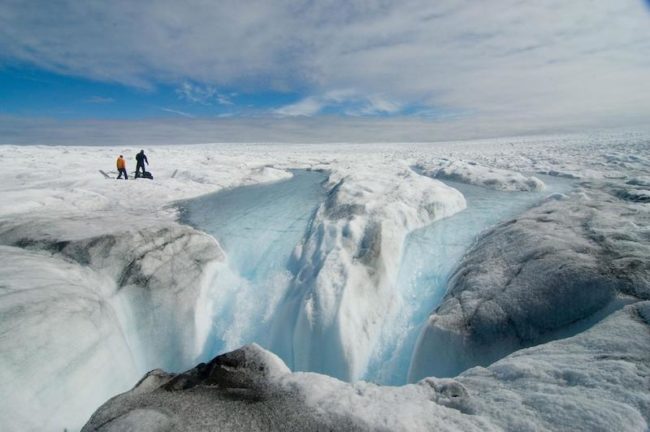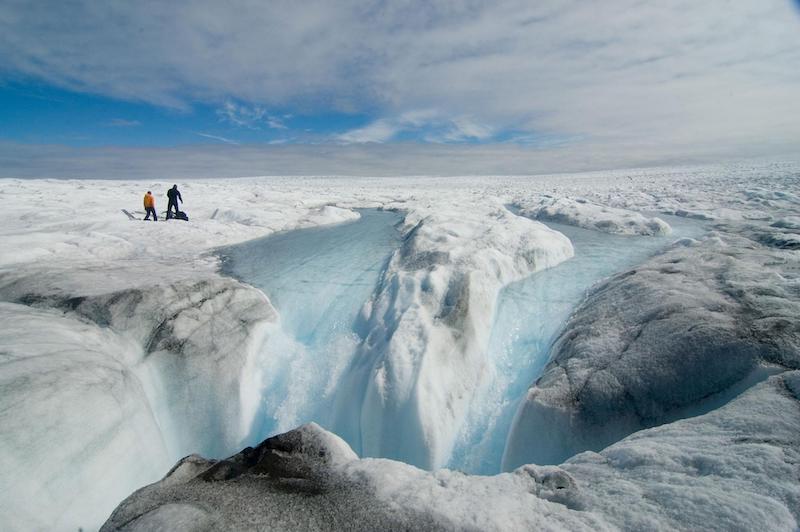
Shocking new insights reveals that the Greenland ice mass is rapidly melting. The rate of now four times faster than it was in 2003. This will lead to a faster sea level rise.
Let’s jump into the actual study and see what it actually tells us.
New Study: Accelerating changes in ice mass within Greenland, and the ice sheet’s sensitivity to atmospheric forcing
Published within PNAS on 22nd January 2019, it uses satellite data to precisely measure what is happening to the ice mass.
Exactly what was measured?
The Gravity Recovery and Climate Experiment (GRACE) consist of a pair of twin satellites (nicknamed “Tom” and “Jerry”) that remain in constance communication.
They use a microwave ranging system to accurately measure changes in the speed and distance between themselves as they fly in a polar orbit about 220 kilometers (140 mi) apart. The accuracy is incredibly fine – The ranging system is sensitive enough to detect separation changes as small as 10 micrometers (approximately one-tenth the width of a human hair) over a distance of 220 kilometers. Every 24 hours they circle the globe 15 times and as they do so, they pickup minute variations in Earth’s gravitational pull. When the first satellite passes over a region of slightly stronger gravity, a gravity anomaly, it is pulled slightly ahead of the trailing satellite. This causes the distance between the satellites to increase. The first spacecraft then passes the anomaly, and slows down again; meanwhile the following spacecraft accelerates, then decelerates over the same point. By measuring the constantly changing distance between the two satellites and combining that data with precise positioning measurements from Global Positioning System (GPS) instruments, it becomes possible to construct a detailed map of Earth’s gravity anomalies.
Changes in Ice mass, when large enough, will alter this measurement, and so over a long timespan a precise measurement of what is happening can be determined.
Key Revelation 1
The largest sustained (∼10 years) acceleration in ice loss detected occurred in southwest Greenland …. but … this is an area largely devoid of glaciers.
This sustained acceleration in mass loss recorded by GRACE before mid-2013 was completely unprecedented.
There has been a scientific focus on the ice loss from glaciers in the southeast and northwest regions but this new study reveals that the greatest degree of ice loss is clearly not glaciers but instead is the melting of the inland ice sheet. Melted ice has been flowing as vast rivers of water into the ocean.
Key Revelation 2
What they measured is that from early 2003 to mid-2013, the total mass of ice in Greenland declined at a progressively increasing rate. In mid-2013, an abrupt reversal occurred, and very little net ice loss occurred in the next 12–18 months. Then in early 2015 that pause ended and the rate of significant ice loss was reestablished.
- The strongest accelerations tracked the phase of the North Atlantic Oscillation
- The negative phase of the North Atlantic Oscillation enhances summertime warming and insolation while reducing snowfall, especially in west Greenland
Since 2000, the North Atlantic Oscillation has worked in concert with global warming to trigger major increases in summertime runoff. Before 2000, the air was too cool for the North Atlantic Oscillation to do this. In a decade or two, global warming will be able to drive 2012 levels of runoff with little or no assistance from the North Atlantic Oscillation. In the shorter term, we can infer that the next time North Atlantic Oscillation turns strongly negative the ice loss will pause once again.
Bottom Line
Within two decades the southwest part of the Greenland Ice Sheet will become a major contributor to sea level rise. There is also the suggestion that enhanced summertime melting may induce more sustained increases in discharge rates.
Lead Author comments
(Via here)
“Whatever this was, it couldn’t be explained by glaciers, because there aren’t many there,” said Michael Bevis, lead author of the paper, Ohio Eminent Scholar and a professor of geodynamics at The Ohio State University. “It had to be the surface mass—the ice was melting inland from the coastline.”
“We knew we had one big problem with increasing rates of ice discharge by some large outlet glaciers,” he said. “But now we recognize a second serious problem: Increasingly, large amounts of ice mass are going to leave as meltwater, as rivers that flow into the sea.”
“The only thing we can do is adapt and mitigate further global warming—it’s too late for there to be no effect,” he said. “This is going to cause additional sea level rise. We are watching the ice sheet hit a tipping point.”
North Atlantic Oscillation…
“These oscillations have been happening forever,” Bevis said. “So why only now are they causing this massive melt? It’s because the atmosphere is, at its baseline, warmer. The transient warming driven by the North Atlantic Oscillation was riding on top of more sustained, global warming.”
“global warming has brought summertime temperatures in a significant portion of Greenland close to the melting point, and the North Atlantic Oscillation has provided the extra push that caused large areas of ice to melt”
“We’re going to see faster and faster sea level rise for the foreseeable future,” Bevis said. “Once you hit that tipping point, the only question is: How severe does it get?”
Tweets
The media have been shouting about this, but is anybody really paying attention?
Some you, but mostly probably not.
